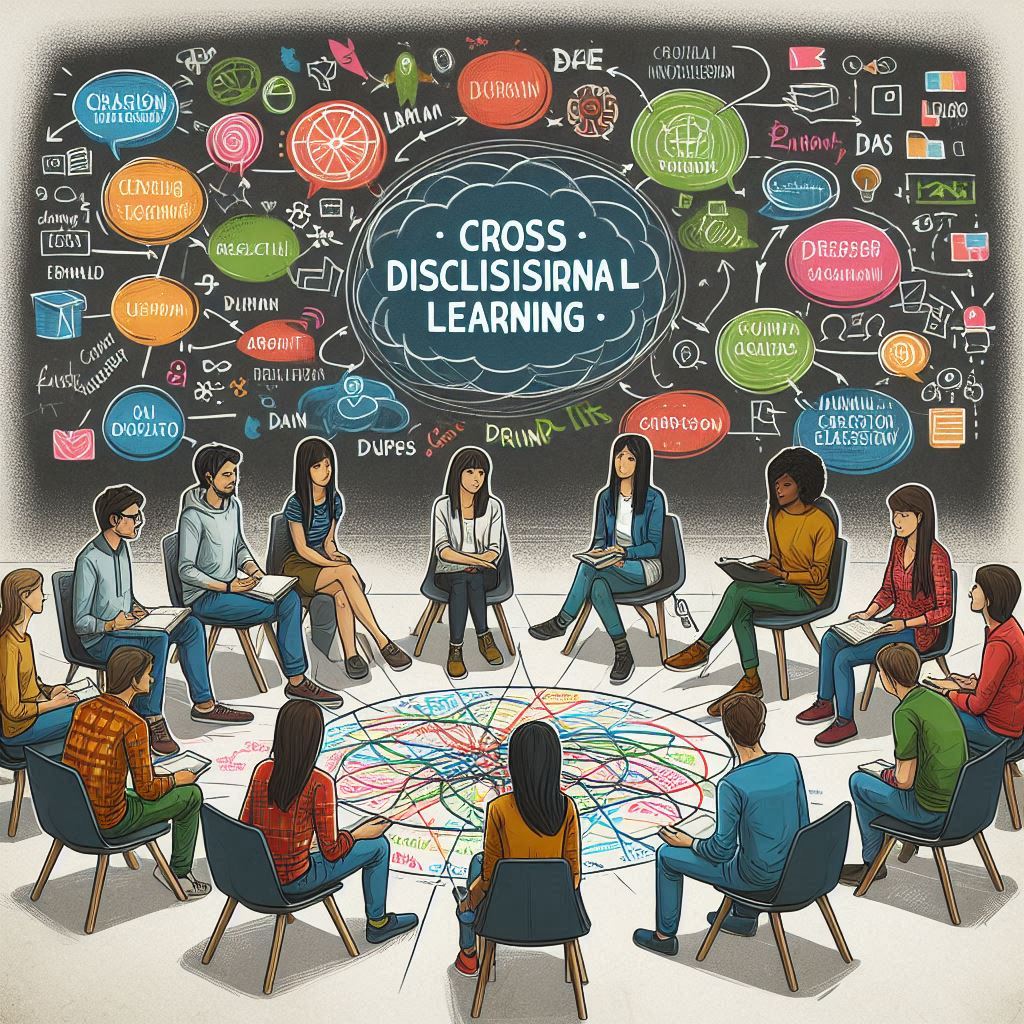Introduction
In today’s fast-paced, interconnected world, the ability to integrate knowledge from various disciplines has become increasingly valuable. Cross-disciplinary learning, which involves blending insights and methods from different fields, offers a range of benefits that can enhance personal growth, professional success, and societal progress.
Understanding Cross-Disciplinary Learning
Definition
Cross-disciplinary learning involves applying knowledge and methodologies from multiple disciplines to address complex problems and create new understanding. Unlike interdisciplinary learning, which integrates methods and perspectives from different disciplines to form a unified approach, cross-disciplinary learning maintains the distinct boundaries of each field while fostering collaboration and cross-pollination of ideas.
Differences from Interdisciplinary and Multidisciplinary Learning
- Interdisciplinary Learning: Integrates concepts and approaches from multiple disciplines into a cohesive framework.
- Multidisciplinary Learning: Involves studying a topic from the perspectives of several disciplines without integrating them.
- Cross-Disciplinary Learning: Encourages collaboration and the application of insights from different disciplines while maintaining their distinctiveness.
Historical Context and Evolution
Historical Examples
Leonardo da Vinci is a prime example of a cross-disciplinary thinker, blending art and science to create innovative works and inventions. His approach set a precedent for the value of integrating diverse fields.
Evolution of Cross-Disciplinary Learning
Over time, the need for cross-disciplinary approaches has grown, driven by the increasing complexity of global challenges. Modern education and professional environments now emphasize the importance of cross-disciplinary learning to foster innovation and address multifaceted problems.
Cognitive Benefits
Enhancing Cognitive Flexibility
Engaging with multiple disciplines enhances cognitive flexibility, allowing individuals to switch between different modes of thinking and adapt to new information and challenges.
Improving Problem-Solving Skills
Cross-disciplinary learning equips individuals with diverse problem-solving strategies, enabling them to approach issues from various angles and develop more comprehensive solutions.
Fostering Creativity
Exposure to different fields stimulates creative thinking by encouraging individuals to draw connections between seemingly unrelated concepts and ideas.
Innovation Through Cross-Disciplinary Approaches
How Blending Disciplines Leads to Innovation
When knowledge from different fields intersects, it can lead to groundbreaking innovations. For example, the combination of biology and engineering has given rise to bioengineering, which has led to advances in medical technology and treatments.
Examples of Innovative Solutions
- Smartphones: A blend of computer science, engineering, design, and psychology.
- Renewable Energy Technologies: Combining principles from physics, engineering, environmental science, and economics.
Real-World Applications
Case Studies in Business, Science, Technology, and Arts
- Business: Companies like Google and Apple thrive on cross-disciplinary teams that integrate technology, design, and user experience.
- Science: The Human Genome Project combined biology, chemistry, and data science to map the human genome.
- Technology: Artificial Intelligence (AI) merges computer science, mathematics, and cognitive science.
- Arts: Digital art forms combine traditional artistic skills with modern technology.
Enhanced Communication Skills
Improving Ability to Communicate Across Fields
Cross-disciplinary learning enhances the ability to communicate complex ideas to people from different backgrounds, fostering better collaboration and understanding.
Benefits in Teamwork and Collaboration
Effective communication across disciplines is crucial for teamwork, enabling diverse teams to work together efficiently and innovatively.
Broader Perspective and Critical Thinking
Gaining a Holistic View
Learning from multiple disciplines provides a broader perspective, allowing individuals to see the bigger picture and understand the interconnectedness of various factors.
Enhancing Critical Thinking
Cross-disciplinary approaches enhance critical thinking by encouraging individuals to analyze problems from different angles and consider multiple viewpoints.
Increased Adaptability and Lifelong Learning
Adapting to Changing Environments
The ability to draw on knowledge from various fields makes individuals more adaptable to change, an essential skill in today’s rapidly evolving world.
Fostering a Love for Lifelong Learning
Cross-disciplinary learning cultivates curiosity and a love for learning, encouraging continuous personal and professional development.
Educational Models for Cross-Disciplinary Learning
Successful Models
- Project-Based Learning: Students work on projects that require knowledge from multiple disciplines.
- Integrated Curriculum: Schools design curricula that blend subjects to provide a holistic education.
Integration into Curricula
Incorporating cross-disciplinary learning into educational curricula prepares students for the complexities of the modern world and equips them with diverse skills.
Benefits for Students
Students exposed to cross-disciplinary learning are better prepared for the workforce, more adaptable, and possess enhanced problem-solving and critical thinking skills.
Challenges and Solutions
Common Challenges
- Balancing depth and breadth of knowledge.
- Integrating different teaching methods and perspectives.
- Overcoming resistance to change in traditional educational systems.
Strategies for Overcoming Them
- Professional Development for Educators: Training teachers to adopt cross-disciplinary approaches.
- Collaborative Teaching Models: Encouraging teachers from different disciplines to work together.
- Flexible Curriculum Design: Allowing for more integration and collaboration between subjects.
Tools and Resources
Online Courses
Platforms like Coursera, edX, and Khan Academy offer courses that blend multiple disciplines.
Books
Books like “Range” by David Epstein and “The Innovator’s DNA” by Jeff Dyer provide insights into the benefits of cross-disciplinary learning.
Workshops
Workshops and conferences on cross-disciplinary learning provide practical strategies and networking opportunities for educators and professionals.
Conclusion
Cross-disciplinary learning offers numerous benefits, from enhancing cognitive flexibility and problem-solving skills to fostering innovation and improving communication. By integrating knowledge from various fields, individuals can develop a holistic understanding of complex issues and drive progress in their personal and professional lives.
FAQs
How does cross-disciplinary learning enhance creativity? It fosters creativity by encouraging the integration of diverse ideas and perspectives, leading to innovative solutions.
Can cross-disciplinary learning be applied in any field? Yes, it benefits various fields, including business, science, technology, and the arts, by promoting collaboration and innovation.
What are some examples of cross-disciplinary approaches in education? Examples include project-based learning and integrated curricula that blend subjects like science, technology, engineering, arts, and mathematics (STEAM).
How can I start incorporating cross-disciplinary learning into my routine? Begin by exploring subjects outside your primary field, taking online courses, and participating in interdisciplinary projects and workshops.
What challenges might I face with cross-disciplinary learning? Challenges include balancing depth and breadth of knowledge and integrating diverse teaching methods. However, these can be overcome with professional development and collaborative teaching models.
Are there resources available for cross-disciplinary learning? Yes, there are numerous online courses, books, and workshops that provide resources and strategies for effective cross-disciplinary learning.



